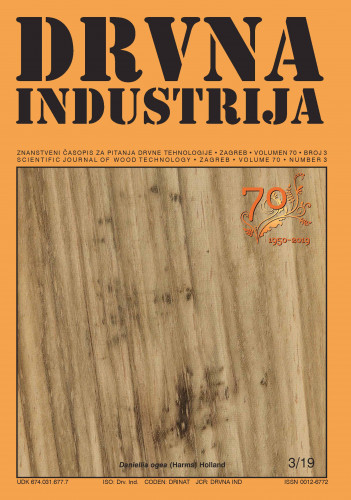A rotary welded joint is a combination of wood in which chemical and physical reactions occur due to friction. During the welding process, heat is generated which softens and melts the wood structure. In this way, interlocked wood fibres in the lignin melt are created within the joint. As the welded joint cools down, it becomes a tight weld. The paper describes the research based on studying the impact of individual factors on the welded joint. Outcome variables are the average ring width, the water content in the wood, and the influence of different humidity levels on the strength of rotary welds. Samples were subjected to the influence of different humidity levels achieved by air conditioning, magnesium chloride and sodium chloride. Absolutely dry samples exhibited the lowest embedded force values (the average embedded force value for heartwood amounted to 1901 N and for sapwood 1920.36 N), while the air conditioned samples (the average embedded force value amounted to 2649.06 N; for sapwood 2679.6 N and for heartwood 2619.6 N). The samples exposed to sodium chloride (the average embedded force value amounted to 2907.7 N; for sapwood 2766.07 N and for heartwood 3049.33 N) exhibited the highest embedded force values. This paper presents a descriptive statistical analysis of the strength of rotary welded dowels in the pine base. The aim of the study was to research the influence of different air humidity levels on the embedded force of Scots pine rotary welds. As the air relative humidity and temperature change during the daily application of the product (which affects the moisture content in the wood), the knowledge on the influence that humidity and water content in the wood exert on the welded joint strength turns out to be of great importance for its use.; Kružno zavareni spoj jest spoj drva u kojemu se zbivaju kemijsko-fizikalne reakcije pod utjecajem trenja. Tijekom procesa zavarivanja stvara se toplina, zbog koje struktura drva omekša i rastali se, pa se te drvna vlakanca u talini lignina međusobno isprepletu. Pri hlađenju zavarenog spoja nastaje čvrsto zavareni spoj. U radu je opisano istraživanje utjecaja pojedinih čimbenika na zavareni spoj, u sklopu kojega su promatrani sadržaj vode u drvu te utjecaj različite vlažnosti zraka na čvrstoću kružno zavarenih spojeva. Uzorci su izlagani zraku različite vlažnosti, što je postignuto njihovim kondicioniranjem te solima magnezijeva i natrijeva klorida. Apsolutno suhi uzorci pokazali su najniže vrijednosti izvlačne sile (prosječna vrijednost te sile za srž iznosila je 1901 N, a za bjeljiku 1920,36 N), a zatim slijede klimatizirani uzorci (prosječna vrijednost izvlačne sile iznosila je 2649,06 N; za bjeljiku 2679,6 N, a za srž 2619,6 N). Uzorci izloženi natrijevu kloridu pokazali su najviše vrijednosti izvlačne sile (njezina prosječna vrijednost iznosila je 2907,7 N; za bjeljiku 2766,07 N, a za srž 3049,33 N). U radu je prikazana deskriptivna statistička analiza čvrstoće moždanika kružno zavarenih u borovinu. S obzirom na to da se pri svakodnevnoj uporabi proizvoda mijenja relativna vlažnost zraka i temperatura (što utječe na promjene sadržaja vode u drvu), poznavanje utjecaja vlažnosti zraka i sadržaja vode u drvu na čvrstoću zavarenog spoja vrlo je važno za njegovu primjenu.
Sažetak

 Drvna industrija : znanstveni časopis za pitanja drvne tehnologije : 70,3(2019) / glavni i odgovorni urednik Ružica Beljo-Lučić.
Drvna industrija : znanstveni časopis za pitanja drvne tehnologije : 70,3(2019) / glavni i odgovorni urednik Ružica Beljo-Lučić.